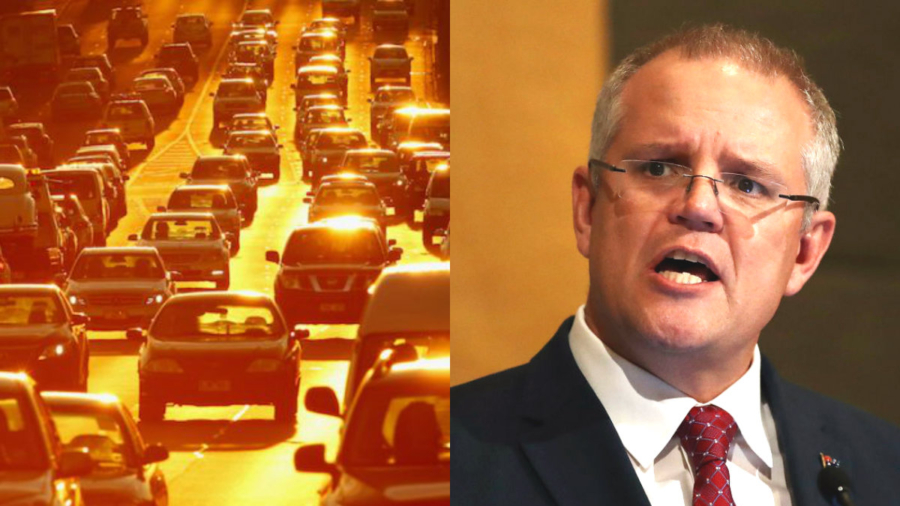Australian Prime Minister Scott Morrison is considering to decrease the permanent migration cap in Australia by 30,000 in efforts to prevent congestion in major Australian cities including Sydney and Melbourne. The annual cap currently sits at 190,000.
While acknowledging the benefit of migration to the economy, Morrison pointed out that he is concerned about how fast the population is growing.
“Population growth has played a key role in our economic success. But I also know Australians in our biggest cities are concerned about population,” Morrison said at the Bradfield Oration in Sydney late Nov. 19, the Sydney Morning Herald reported.
“They are saying: enough, enough, enough.”
“I’m very concerned about the rate of population growth … not the existence of population growth, but the pace of population growth,” Morrison told the media.
He says the two major cities of Sydney and Melbourne, in particular, have been experiencing negative effects such as congestion—a situation city commuters find themselves in on a daily basis.
“The roads are clogged, the buses and trains are full. The schools are taking no more enrolments. I hear what you are saying. I hear you loud and clear,” Morrison said, according to AAP. “We have become, especially in Sydney and Melbourne, a victim of our success.”
According to the ABS, Australia’s population hit 25 million in August this year. Annual population growth was 1.6 percent this year, and immigrants accounted for the majority of that growth at 62 percent.
To address the issue, Morrison says that a “bottom-up” approach is what’s needed, whereby the states, territories, and local governments are involved in the discussion as to how to manage and plan for the changing population.
“Far too often, planners have treated population as one amorphous blob, but that doesn’t work for Australia. We’re too big and diverse,” Morrison said, according to AAP.
“Talking about average population growth is like talking about average rainfall. It fails to recognise the different experiences and outlooks of cities or regions.”
He gave an example of Sydney experiencing “pressure points” that other regions may not experience.
“In Sydney, migrants accounted for around 70 per cent of population growth last year. This has created its own pressure points, and pressure points in population always manifest themselves in housing and infrastructure,” he said.
In 2010, Australia’s Treasury projected that Australia would reach 35.9 million by 2050. In 2015, the Treasury said Australia’s population would be about 39.7 million by 2054–55.
However, according to projections by Australia’s Centre for Population and Urban Research, the population was looking to reach 42 million by 2050—about 6 million more than the Treasury’s projections—based on current immigration numbers.
Sydney and Melbourne were expected to account for up to 16 million by 2050, according to ABS.
Sydney and Melbourne ‘Really Struggling’
Morrison plans to ask state and territory leaders to bring their population strategies to the next Council of Australian Governments meeting in December so that governments can examine how many migrants their jurisdictions can realistically allow for, AAP reported.
Population Minister Alan Tudge reiterated Morrison’s message on Nov. 20.
“It’s not a one-size fits all,” Tudge said. “We want to support the aspirations and the capacity of each of those states to grow so we can support the growth in some of the smaller states. But we might ease the pressure on the growth in Melbourne and Sydney, who are really struggling with the very rapid growth, most of which is driven by migration.”
Tudge said he plans to release a full population policy early next year, according to the Australian.
Cabinet minister Christopher Pyne said that population policy should not be dictated by public opinion.
“We don’t need to put a handbrake on population growth,” Pyne told Sky News on Nov. 19. “We need to manage our population growth sensibly in a country, which quite frankly, can take a lot more than 25 million people.”
Labor leader Bill Shorten said that affordable housing may help to tackle overcrowding in major cities.
“Some politicians today talk about slowing down the population whilst the cities catch up,” Shorten said in an address to the Community Housing Industry Association in Melbourne, AAP reported. “Building social housing is exactly what needs to happen to catch up.”
Chief executive of Property Council of Australia Ken Morrison said the government needs to look at other cities around the world for inspiration.
“It’s not their size that matters. It’s how well they’ve been planned,” he said, AAP reported.
“Immigration doesn’t create bad planning; bad planning creates bad planning.”


